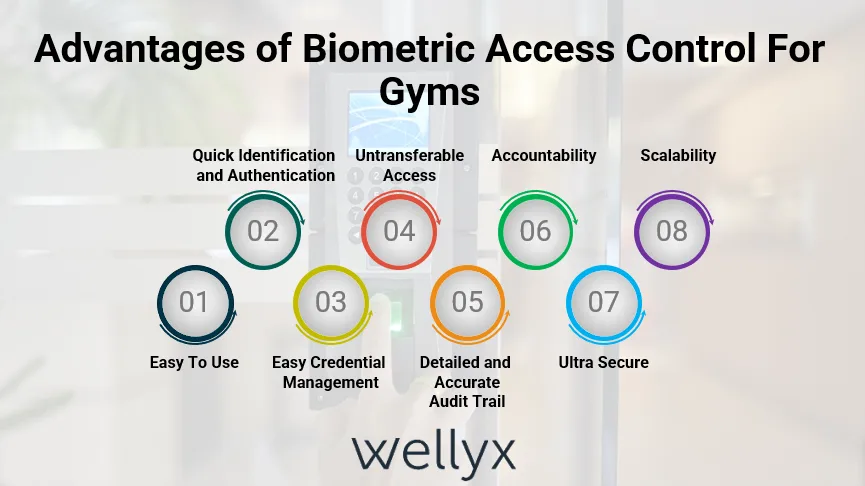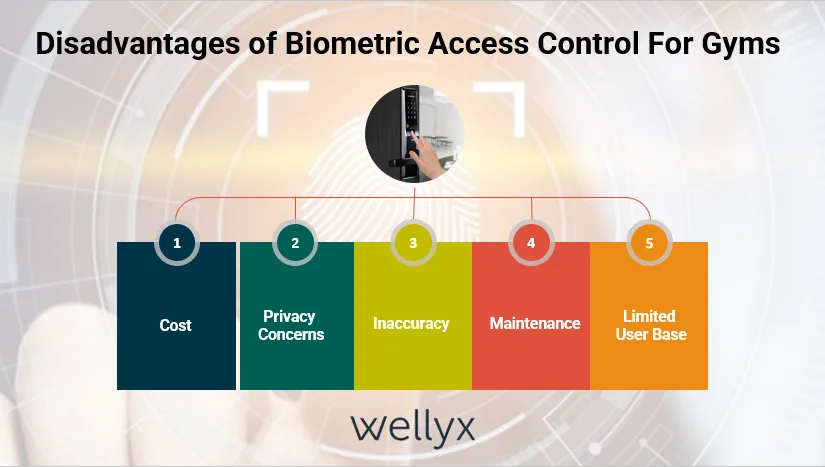Biometric technology is proliferating and has been getting used in all industries, specifically for security and access control. That is why biometric system’s market size is growing and has increased from US$ 10.74 billion in 2015 to $32.73 billion by 2022, at a compound annual growth rate (CAGR) of 16.79% from 2016 to 2022, according to the research firm Markets and Market.
Despite these statistics, it is always imperative to learn about the benefits and potential risks when it comes to implementing such technology in your business. Specifically, when you are a gym owner, you must deliberate the possible outcomes of installing a biometric-based access control system. Therefore, in this blog post, we are covering the pros and cons of using a biometric access control system for gyms.
What is biometric access control and how does it work for gyms?
Biometric access control is a security mechanism that uses physical characteristics unique to an individual, such as facial recognition, fingerprints, or iris scans, to grant access to a specific location or device. In the context of gyms, biometric-based access control is used to restrict entry to only authorized individuals, such as gym members, trainers, and staff.
The process of the biometric check-in-check-out system for gyms typically involves the following steps:
- Registration: Gym members are required to register their biometric data, usually by scanning their fingerprints or facial features. This information is then stored in a secure database.
- Verification: When gym members want to enter, they must scan their biometric data at the entrance. The system will then compare the scanned data with the data stored in the database to verify their identity.
- Access Grant: If the system confirms the identity of the gym member, the access control system will grant them access to the gym. Access will be denied if the system does not recognize the scanned data.
This access control system offers several advantages over traditional access control systems. It is more secure because biometric data is exclusive to each individual and cannot be replicated or forged easily. It is also more convenient for gym members because they do not need to carry any access cards or remember any codes. Overall, biometric access control provides a more efficient and secure way to manage access to gyms.
Pros of biometric access control for gyms

Using a biometric access control system is beneficial in a lot of ways. A few of its prominent benefits are listed below as;
1. Easy to use
These systems are user-friendly and require minimal training. With this technology, gym-goers don’t have to worry about carrying keys or remembering PINs or passwords, as biometric authentication can be done using a fingerprint, face, or iris scan.
2. Quick identification and authentication
Biometric access control systems are very efficient at identifying and authenticating users. They do so quickly and accurately, which helps to reduce wait times for gym-goers and can improve the overall user experience.
3. Easy credential management
These systems eliminate the need for physical credentials such as keys or access cards. It means gym owners don’t have to worry about managing and replacing lost or stolen cards or keys. This aspect makes these systems time-saving and cost-efficient.
4. Untransferable access
Biometric-based access control systems provide unique access to each individual, making it virtually impossible for someone else to use another person’s access. This eliminates the possibility of sharing credentials or unauthorized access, which can help ensure gym-goers’ safety and security.
5. Detailed and accurate audit trail
They provide detailed and accurate audit trails, meaning gym owners can track who enters and exits their facility and when. This information can help identify suspicious activity, monitor peak times, and improve security protocols.
6. Accountability
Such access control systems increase accountability by recording who has accessed the gym and when. This makes it easier to identify any issues or concerns that may arise and take appropriate action if necessary.
7. Ultra secure
Using biometric systems for access control is highly secure as these systems use unique biological characteristics that cannot be replicated or shared. This eliminates the possibility of credential theft or duplication, making them a very effective security measure.
8. Scalability
Biometric access management systems are scalable as well as integrable into existing gym systems or expanded as needed. This makes them a flexible and adaptable solution that can grow with a gym’s needs.
Overall, these systems offer many benefits for gym owners and users alike. They are easy to use, secure, and provide detailed audit trails, effectively improving gym security and access control.
Cons of biometric access control for gyms

While biometric access control systems offer several advantages for gym owners, there are also some potential drawbacks to consider:
1. Cost
Biometric-based access control systems can be a bit expensive to install and maintain compared to traditional access control systems. The cost of biometric sensors and software can be moderately high, and ongoing maintenance and updates may be required.
2. Privacy concerns
Biometric data is sensitive personal information, and some people may have privacy concerns about providing their biometric information to a gym. There is also the risk that biometric data could be scythed or pilfered, leading to identity burglary or other security breaches.
3. Inaccuracy
While biometric authentication is generally very accurate, there is still a chance for errors or false positives. This could result in legitimate gym-goers being denied access or unauthorized individuals gaining access to the facility.
4. Maintenance
Biometric sensors and software require regular maintenance and calibration to ensure accurate readings. Failure to maintain the system properly could lead to false readings or malfunctioning sensors.
5. Limited user base
Not everyone is comfortable using biometric access control systems or may be unable to use them due to physical disabilities or medical conditions. This could limit the user base of a gym that relies solely on biometric authentication for access control.
Conclusion
While biometric access control systems offer many advantages for gyms, there are also some potential drawbacks. Gym owners must carefully evaluate the costs and benefits of biometric access control before deciding whether to implement this technology. Additionally, gym owners should address privacy concerns and ensure the system is maintained correctly to minimize the risk of errors or malfunctions.
Frequently asked questions
1. How secure is biometric access control in comparison to traditional access control methods?
Biometric access control is generally more secure than traditional methods because it uses unique biological characteristics that cannot be replicated or shared. This eliminates the possibility of credential theft or duplication, making it a very effective security measure.
2. How accurate is biometric authentication?
Biometric authentication is generally very accurate, but there is still the potential for errors or false positives. This could result in legitimate gym-goers being denied access or unauthorized individuals gaining access to the facility.
3. How do I address privacy concerns with my gym-goers?
Gym owners should be transparent about collecting, storing, and using biometric data. They should also have a clear privacy policy in place and allow gym-goers to opt out of biometric authentication.
4. How do I ensure that my biometric access control system is appropriately maintained?
Biometric sensors and software require regular maintenance and calibration to ensure accurate readings. Gym owners should work with their system provider to develop a maintenance plan and schedule regular inspections and updates.
5. Should I use biometric access control as my gym’s sole access control method?
While biometric access control offers many advantages, it may not be suitable as the sole access control method. Gym owners should consider using multiple access control methods, such as biometric authentication combined with access cards or PIN codes, to ensure maximum security and flexibility.